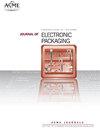无铅焊点的剪切和疲劳性能:建模和微观结构分析
IF 2.3
4区 工程技术
Q3 ENGINEERING, ELECTRICAL & ELECTRONIC
引用次数: 13
摘要
在电子工业中禁用铅后,由于其毒性,sac基焊料合金的可靠性得到了广泛的研究。低温焊料(LTS)合金因其低成本和减少复杂组件中的缺陷而受到广泛关注。采用Instron微力学测试系统对单个焊点的剪切和疲劳性能进行了测试。研究了两种新型低温钎料合金Sn-58Bi-0.5Sb-0.15Ni和Sn-42Bi,并与Sn-3.5Ag和Sn-3.0Ag-0.8Cu-3.0Bi进行了比较。在测试过程中,表面光洁度为化学镀镍浸金(ENIG)。在三种应变速率下进行了剪切试验,并测量了每种焊料合金的剪切强度。采用恒应变速率进行循环疲劳试验。测定了各合金在不同应力幅值下的疲劳寿命。利用扫描电镜/能谱分析(SEM/EDS)对剪切和疲劳试验中的破坏机理进行了表征。结果表明:Sn-3.0Ag-0.8Cu-3.0Bi合金具有较好的剪切性能和疲劳性能,但更易发生脆性破坏;剪切应变速率影响Sn-3.0Ag-0.8Cu-3.0Bi、Sn-58Bi-0.5Sb-0.15Ni和Sn-42Bi的破坏模式;而Sn-3.5Ag则不敏感。Sn-3.5Ag在抗剪强度和疲劳试验中检测到多种破坏模式。本文章由计算机程序翻译,如有差异,请以英文原文为准。
Shear and Fatigue Properties of Lead-Free Solder Joints: Modeling and Microstructure Analysis
The reliability of SAC-based solder alloys has been extensively investigated after the prohibition of lead in the electronics industry owing to their toxicity. Low-temperature solder (LTS) alloys have recently received considerable attention because of their low cost and reduced defects in complex assemblies. The shear and fatigue properties of individual solder joints were tested using an Instron micromechanical testing system in this research. Two novel solder alloys (Sn-58Bi-0.5Sb-0.15Ni and Sn-42Bi) with low melting temperatures were examined and compared with Sn-3.5Ag and Sn-3.0Ag-0.8Cu-3.0Bi. The surface finish was electroless nickel-immersion gold (ENIG) during the test. Shear testing was conducted at three strain rates, and the shear strength of each solder alloy was measured. A constant strain rate was used for the cyclic fatigue experiments. The fatigue life of each alloy was determined for various stress amplitudes. The failure mechanism in shear and fatigue tests were characterized using scanning electron microscopy/energy-dispersive spectroscopy (SEM/EDS). The results revealed that Sn-3.0Ag-0.8Cu-3.0Bi had superior shear and fatigue properties compared to other alloys, but was more susceptible to brittle failure. The shear strain rate affected the failure modes of Sn-3.0Ag-0.8Cu-3.0Bi, Sn-58Bi-0.5Sb-0.15Ni, and Sn-42Bi; however, Sn-3.5Ag was found to be insensitive. Several failure modes were detected for Sn-3.5Ag in both shear strength and fatigue tests.
求助全文
通过发布文献求助,成功后即可免费获取论文全文。
去求助
来源期刊

Journal of Electronic Packaging
工程技术-工程:电子与电气
CiteScore
4.90
自引率
6.20%
发文量
44
审稿时长
3 months
期刊介绍:
The Journal of Electronic Packaging publishes papers that use experimental and theoretical (analytical and computer-aided) methods, approaches, and techniques to address and solve various mechanical, materials, and reliability problems encountered in the analysis, design, manufacturing, testing, and operation of electronic and photonics components, devices, and systems.
Scope: Microsystems packaging; Systems integration; Flexible electronics; Materials with nano structures and in general small scale systems.
 求助内容:
求助内容: 应助结果提醒方式:
应助结果提醒方式:


